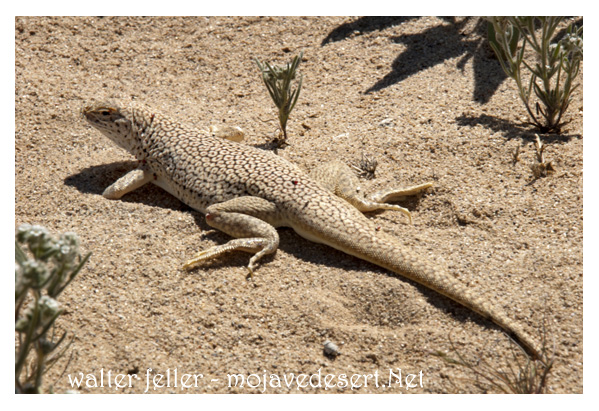Mojave Fringe-toed Lizard

The Mojave fringe-toed lizard (Uma scoparia) is a small, highly specialized reptile native to the harsh environments of the Mojave Desert. This lizard has developed a range of fascinating adaptations that allow it to thrive in one of the most challenging habitats on Earth.
Physical Characteristics
Size: These lizards typically measure between 4 to 6 inches in length, including their tail.Coloration: Their sandy, pale coloration serves as excellent camouflage, blending in with the desert surroundings and helping them avoid predators like birds, snakes, and larger reptiles.
Fringed Toes: The Mojave fringe-toed lizard is named for the unique fringes along the edges of its toes. These elongated, scale-like projections increase the surface area of the feet, enabling the lizard to move quickly across loose, sandy terrain without sinking, much like having built-in sandshoes.
Eyelid Adaptations
Protection from Sand: The lizard's eyelids are crucial for protecting its eyes from the abrasive desert sand. In the Mojave Desert, where winds can easily stir up sand particles, these eyelids act as a barrier, shielding the lizard's eyes when it burrows or during sandstorms.Transparent Lower Eyelid: One of the most interesting features is the lizard's partially transparent lower eyelid. This allows the lizard to close its eyes for protection while still being able to see, giving it the advantage of spotting predators or prey even when its eyes are covered.
Blinking and Moisturizing: To keep its eyes moist and clean in the dry desert environment, the lizard frequently blinks. This is essential for preventing the eyes from drying out, ensuring the lizard maintains clear vision.
Habitat
Desert Specialists: Mojave fringe-toed lizards are found in areas with loose, fine sand such as sand dunes, washes, and other sandy regions within the Mojave Desert, which spans parts of California, Nevada, and Arizona.Sand Swimming: A remarkable behavior of these lizards is their ability to "swim" through sand. By undulating their bodies in a sinuous motion, they can quickly burrow beneath the surface to escape predators or to find a cooler spot during the intense desert heat.
Behavior and Diet
Thermoregulation: Being ectothermic, these lizards rely on external heat sources to regulate their body temperature. They are most active during the cooler parts of the day, such as early morning and late afternoon. During the hottest parts of the day, they seek shelter by burrowing into the sand or hiding under vegetation.Diet: The Mojave fringe-toed lizard feeds mainly on small insects like ants, beetles, and grasshoppers. They also consume plant material, including seeds and flowers, which provide additional moisture and nutrients.
Breeding: Their breeding season typically occurs in spring and early summer. Females lay clutches of 2 to 5 eggs in the warm sand, where the eggs incubate for about 60 days before hatching. The young lizards are independent from birth.
Conservation Status
Threats: The Mojave fringe-toed lizard faces threats primarily from habitat loss. Human activities such as off-road vehicle use, urban development, and agriculture can destroy the delicate sandy habitats these lizards rely on for survival.Conservation Efforts: Conservation efforts focus on preserving the natural habitats of these lizards. This includes restricting off-road vehicle access to sensitive areas, protecting sand dunes from development, and conducting research to monitor population health and trends.
Ecological Importance
Ecosystem Role: The Mojave fringe-toed lizard plays a crucial role in the desert ecosystem. By preying on insects, they help control insect populations, and as prey themselves, they support a variety of desert predators, contributing to the biodiversity of their habitat.In summary, the Mojave fringe-toed lizard is a master of desert survival, with unique physical traits and behaviors that allow it to navigate and thrive in its sandy, sun-scorched environment. Its fringed toes, specialized eyelids, and ability to "swim" through sand are just a few of the remarkable adaptations that make this lizard perfectly suited to the Mojave Desert. Conservation of its habitat is essential to ensuring the continued survival of this extraordinary species.
The fringe-toed lizard of the Mojave Desert seems to have carved quite a niche in this desert environment. This is a well-adapted organism that exists on fine, loose sand and has some cool adaptations that
help it live there. What's neat with this lizard is that when it feels threatened, it can run only on its hind legs with great speed and then dive right into the sand to hide. Such skill is required should
the fringe-toed lizard find itself in a situation where it needs to flee from predators like roadrunners, badgers, and coyotes. For that matter, even birds, which include loggerhead shrikes and American kestrels,
would have a field day getting their beaks on these lizards. It is not enough that they must be ready for any sudden attack by mammals or birds, but also reptiles, such as snakes like sidewinders, glossy snakes,
and coachwhips, that would not say no to having a fringe-toed lizard for lunch or dinner.
sand dunes
dry lakebeds
desert washes
alkali scrub
desert shrub
habitats